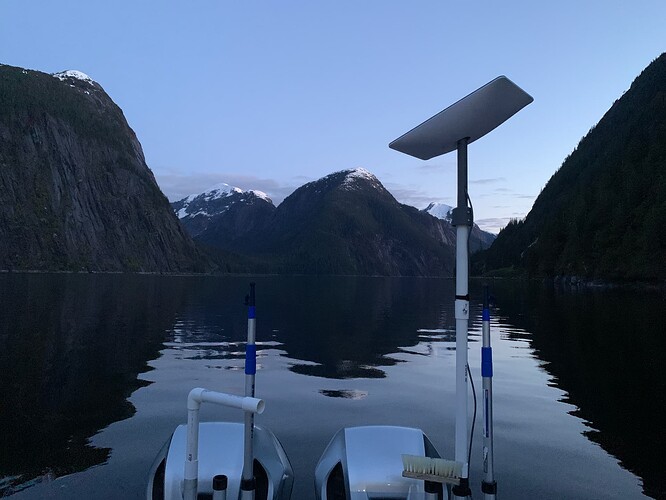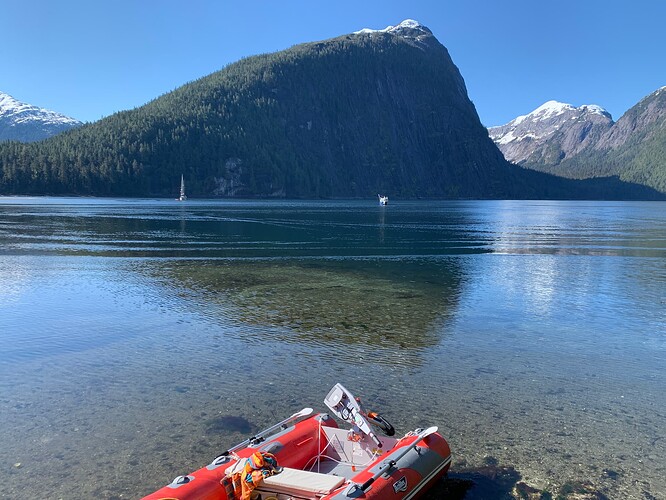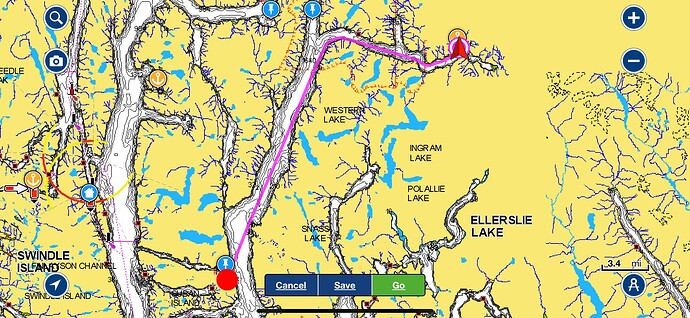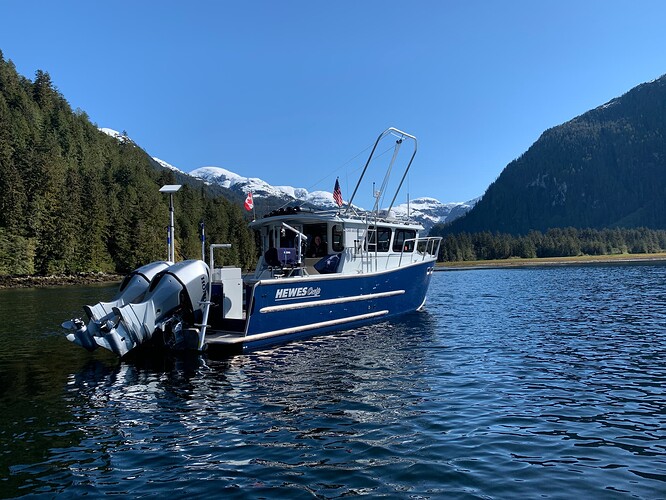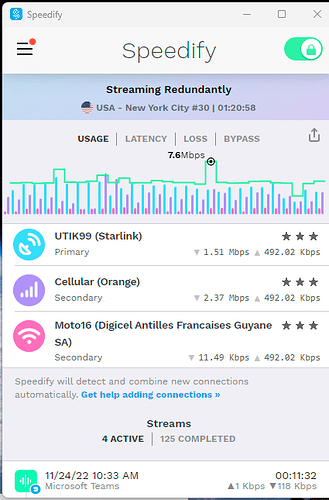Have you been to Desolation Sound before? Cellular coverage is extremely spotty. If you plan to cruise there you need to be comfortable with no cell coverage for periods of time, or plan your agenda around those locations that do have service. And if you’re looking farther north, the Broughtons for example have extremely scarce cell coverage.
Hi there. We have leased a slip at Shilshole Bay also. I just went on and it says that it may not be available for that address until 2023. Did you have this issue or was there way around it? Should I just pay the deposit of $99 and wait to see what they say?
Our Starlink has more than proven itself now and is an abolutely outstanding remote communications device. Here are a couple of shots from remote British Columbia today where there is absolutely no Cellphone coverage and very limited VHF due to the mountains and fiords etc. Starlink not only provides a solid 150+MB/SEC connection at anchor here which is astonishing for a start, but it also provides a comms hub for another boat about 100yards away (2 bars wifi signal strength) such that they could watch paramount +! I wnet ashore in the dinghy this morning, also had two bars, sent 8 high res photos back to my wife on the boat. Using Tmobile, wifi calling is also a breeze, and it works fine in the 100=150 yard radius from the boat, possibly more as I have not tested it further yet. In summary…Amazing performance. Our window pilot house likely helps and the starlink router is on the dining table so is about 6-7 feet above the water line. Cheers Kiwi
Beautiful pictures! I’m up in BC as well and have loved having high speed internet wherever we are. Later this week we will be exploring even deeper into the non-cellphone territory and hope to leverage Starlink to continue enjoying our time here!
SpaceX announced Starlink for RV’s today which is a new offering. Before you rush out to get it, here are some observations:
- Appears to be a new plan, not new hardware. It costs the same as standard Starlink + Portability at $135 a month.
- Turn on/off - you can enable/disable the plan in case you aren’t using it for specific months out of the year, which might be nice for non-year-round boaters.
- Throttling - this is probably the most concerning if you are expecting similar performance to standard Starlink. There is a lot of language around slowing down your connection in waitlisted or congested areas, and even speeds around 5Mbps are mentioned, which is quite a bit slower than cellular. But if you are somewhere there is no cellular coverage at all, it still could be a game changer.
The folks over at the Mobile Internet Resource Center have produced a detailed article on the info they’ve found so far SpaceX Launches Official "Starlink For RVs" - Deprioritized Service That Can Be Paused As Needed - Mobile Internet Resource Center
I agree with their conclusions as well. If you are a year round boater, and want connectivity everywhere, all the time, then standard Starlink + Portability is likely a better solution. If you only need Starlink part of the year, then the RV plan makes sense.
I just completed a straight DC install powering the dish via PoE and ditching the Starlink router for my Peplink Max Transit. Many thanks to SV Renaissance for these instructions. Everything is working flawlessly and I can even stow the dish using the app over my local network via the special Peplink firmware update linked in the article.
One deviation from the instructions that didn’t work out was substituting the Tycon 1256 DC-DC converter for the recommended no-name boost block. While the new version dish may only use a modest amount of juice when it is up and running, it draws a peak load during boot up in excess of the 70 watts that the Tycon can put out. It’s remarkable that there don’t seem to be any higher output 12 V to 48 or 56 V boost converters from name-brand manufacturers, but I sure couldn’t find any. Fortunately the off-brand blocks are cheap enough to keep a spare on hand, and there is always the Starlink router in a pinch.
I’m very much looking forward to using this for remote work in Canada starting later this month, and am greatly encouraged by reports from folks who are already there. I signed up for the residential + portability using an undersubscribed cell in Eastern Washington as my home location before the RV plan was announced. Starlink support says that there isn’t currently a way to switch from one plan to the other without returning equipment, but I suspect this is a provisioning rather than a hardware issue as the unit for both plans is to all appearances the same.
I’ve heard that portability users will need to switch their home service location to one that is in-country after crossing the border to roam into Canada. Should be pretty trivial via the account page if true. Can anybody confirm or deny?
Awesome that you were able to get it working. Just an FYI that you don’t need a special firmware anymore - most all Peplink products running version 8.2.0 have the management address feature built in.
I’ve struggled finding these as well. There are higher powered ones that I’ve found from other manufacturers, but they are very expensive and less efficient in their power conversion. They are also quite a bit bigger than the Tycon and cheaper ones off of Amazon.
I am in Canada right now, specifically sitting in Princess Louisa Inlet, and have had wonderful service everywhere in Canada I’ve been the last 2+ weeks. I have an RV plan dishy coming too just for testing the plan. From what we know, the dishes are identical - it’s just the plans. And Starlink have not indicated there will ever be a way to switch to the RV plan from the residential one. Given their other restrictions in their processes, I would not hold out hope…
You can’t switch countries from the US to Canada as far as I’ve tested and heard from others. As a result, I believe we are limited to 2 months of use within Canada before it will stop/the plan will be terminated (depends on how you interpret their very high level ToS).
Here’s what Starlink support told me about switching to the RV plan:
Hi Ian, unfortunately, we cannot transfer a residential account to a Starlink for RV account with out returning and purchasing new hardware at this time, but since you already have an active residential Starlink account, you have the option to add the portability feature. This will allow you to travel with your Starlink while portability is enabled just like the RV offering, but also turn it off when you return your registered service address for prioritized service and not pay the additional fee. Adding portability to your account will be equivalent in cost to Starlink for RVs as well as allow you to receive the same best effort service.
Probably being overly optimistic in hoping that “at this time” means “not never.” ![]()
Re duration of use abroad, do you know if the two month period resets if you return to your home country? The TOS are rather vague, as you say.
This “industrial” PoE is claimed to put out 95W and looks pretty solid. Looks like that should be able to handle the peak load during startup.
No idea. Lots of folks have been asking but I don’t think there is a definitive answer yet.
True, but this one would require a 48-56v power supply as well. I just wish someone would make a decent PoE power supply for boats but it is such a small market…
I’ve install the Starlink antenna on my sailboat and currently in St Martin at anchor it works incredibly well for teleworking with Teams !
I’d like to have a permanent installation on a mast but the Furuno radar is already on the other side of the boat. Wondering what would be the minimal separation from a running 4kw radar because its hard to find a place where the boat heeling won’t have an impact.
Hi Andre,
Interference from radars is something you should test for the particular brand, band, and location. I’ve had reports from people using just about every brand of modern radar causing issues with Starlink if it is too close or in the band or path of the radar beam. Some others who have used Garmin and Raymarine have said they have had no issues, no matter how close their Starlink was mounted.
Thanks Steve. FYI i have a friend who just crossed on his sailboat from Norfolk to St-Martin with a Starlink antenna they had modified to stay flat. They never lost the signal… they had 40+ knots winds in the vicinity of Nicole while beating their way. Boat movement was incredible but they always had internet. This is incredible !
I’ve heard from tons of folks who are seeing similar things - no blocking of offshore use (which is only supposed to work on the Maritime dishes), no enforcement of the speed limits for in-motion use, and more.
I can only imagine that it is just for now, and that Starlink will start being more aggressive with those restrictions once folks get hooked on how easy it is to use, and end up purchasing the more expensive versions ![]()
I did the test with the antenna flat (motor disabled) vs motor at the latitude of St-Martin and more shorter disruption than with antenna active. I’ve seen that you analyzed the new amplified flat antenna its not the price that bother me its the 100W energy drain. Thats too much for me on a sail boat.
Remains to see what the future will bring but for the moment, great service !
Speedify is great technology, and I love their visualizations and ability to track the apps that are using the connection. It’s hard to use with Peplink or other dedicated routers without using their hotspot sharing, which I think just complicates things.
I think if you already have a couple of internet sources, and don’t have a dedicated router like a Peplink with things like SpeedFusion already in it, then Speedify is a great way to add some redundancy without that expense.
I was invited live on one of the Speedify broadcast to talk about my experience teleworking on a boat:
